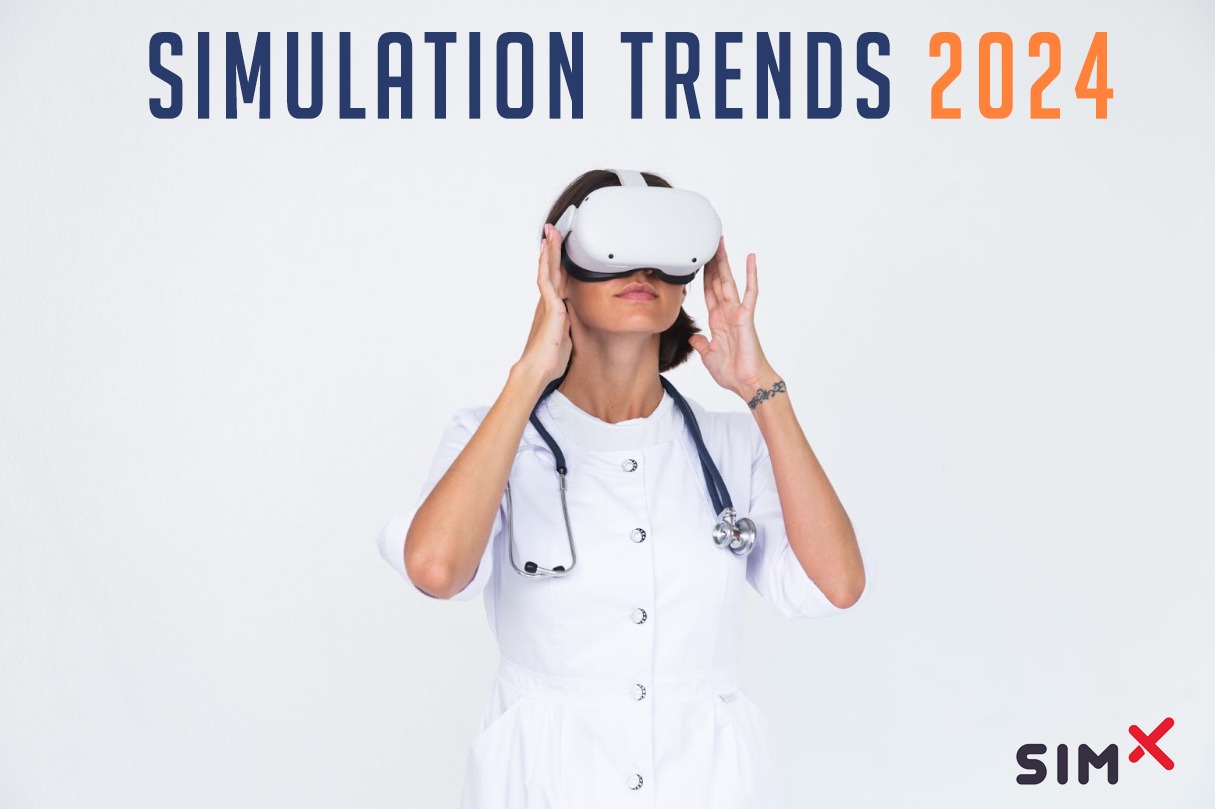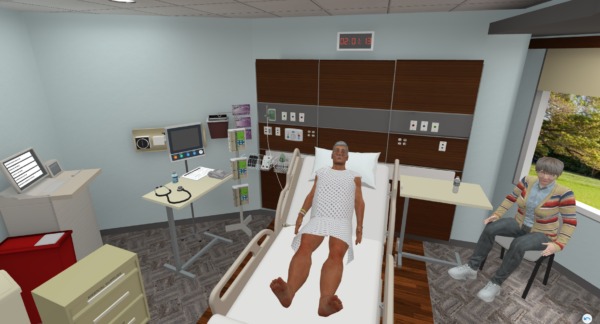SimX is completely changing the way healthcare providers undergo simulation training. For decades, patient manikins have evolved to incorporate varying...
Top 5 Medical Simulation Trends of 2024: VR Leads the Way

The realm of medical simulation is rapidly evolving, and as we venture into 2024, certain trends are prominently shaping the future of medical training. SimX VR, a virtual reality (VR) medical simulation leader, is at the forefront of these transformative changes. This article delves into the top five medical simulation trends of 2024 and highlights how SimX VR is setting new standards in this dynamic field.
Overview of Medical Simulation Trends
The medical simulation industry witnessed remarkable growth over the past years, evolving from basic manikins to sophisticated VR environments. In 2022, the global VR medical simulation industry was valued at $954.6 M USD. It is projected to advance at a CAGR of 25.6% from 2023 to 2031 and reach $8.5 B USD by 2031.
This evolution mirrors the advancements in technology and the increasing need for more realistic, accessible, and cost-effective training methods in the medical field. Technological advancements and innovation in VR technology are expected to drive the global VR medical simulation market over the next few years.

Importance of SimX VR in 2024
SimX VR, a trailblazer in the domain of VR-based medical simulation, has emerged as a key player in shaping the 2024 trends. Its innovative solutions have revolutionized the way medical professionals train, offering immersive, realistic, and interactive experiences that closely mimic real-life medical scenarios.
Significant growth factors include SimX’s partnership with Laerdal in early 2023. Laerdal Medical, a leader in patient simulation, and SimX announced a partnership to help increase patient safety with VR simulation training. Under this partnership, Laerdal became a main distributor of the SimX virtual reality simulation platform for hospitals, EMS, and government customers in the U.S. and Canada.
As a global industry leader, SimX can be found in over 20 countries and in many of the top U.S. hospitals. This influence allows SimX to make the dream of “any time, anywhere” medical simulation training possible all over the world.
Trend 1: Advanced Virtual Reality Integration
The first significant trend in medical simulation for 2024 is the advanced integration of VR technologies. VR has transcended the boundaries of traditional learning, offering immersive environments that replicate real-life medical situations with astonishing accuracy. VR technology has seen leaps in terms of graphical fidelity, user interaction, and scenario complexity. These enhancements allow for more nuanced and realistic simulations, greatly benefiting medical training.
SimX VR has been at the vanguard of utilizing these technological advancements. By offering highly realistic and interactive scenarios, SimX VR enables medical professionals to practice and hone their skills in a safe, controlled environment, bridging the gap between theory and practical application.
Importance of SimX VR in 2024
A key player in shaping the 2024 trends is SimX. SimX is a trailblazer in the domain of VR-based medical simulation because it is one of the first medical training companies (it was founded in 2013), and it’s the only company that was founded by physicians for physicians. Its innovative solutions have revolutionized the way medical professionals train: SimX’s Simulated Patient Encounters offer immersive, realistic, and interactive experiences that closely mimic real-life medical scenarios.
SimX’s patented software has made them an important global industry leader: SimX is found in over 20 countries, in many of the top U.S. hospitals, and is even used by the U.S. Department of Defense. And SimX isn’t stopping in its quest to make “any time, anywhere” medical simulation training possible worldwide.
In early 2023, SimX announced a partnership with Laerdal Medical. Laerdal Medical, a leader in patient simulation, and SimX partnered to help increase patient safety with VR simulation training. Under this collaboration, Laerdal became a main distributor of the SimX virtual reality simulation platform for hospitals, EMS, and government customers in the U.S. and Canada.
Trend 1: Advanced Virtual Reality Integration
The first significant trend in medical simulation for 2024 is the advanced integration of VR technologies. VR has transcended the boundaries of traditional learning, offering immersive environments that replicate real-life medical situations with astonishing accuracy. VR technology has seen leaps in terms of graphical fidelity, user interaction, and scenario complexity. These enhancements allow for more nuanced and realistic simulations, which greatly benefits medical training.
SimX VR has been at the vanguard of utilizing these technological advancements. By offering highly realistic and interactive scenarios, SimX VR enables medical professionals to practice and hone their skills in a safe, controlled environment, which bridges the gap between theory and practical application.
Trend 2: Dynamic and Customizable Scenarios
The ability to customize simulations revolutionizes training and educational environments by enabling learners and educators to build virtual patient encounters according to specific learning objectives. Many VR medical simulation companies offer “scenario builders” where users can select certain settings to provide learners with unique challenges and dynamic patient encounters.
In 2023, SimX updated its Virtual Manikin Series with custom case creation technology, revolutionizing medical simulation education worldwide. The SimX Virtual Manikin Series is a customizable collection of simulated patient encounters that allows educators to select patient avatars, environments, and scenario outcomes to create unique simulations. The Virtual Manikin can respond to and interact with learners in an effort to gain true-to-life clinical experience. Unlike physical manikins often utilized in traditional medical simulation, the Virtual Manikin can be set up in less than 5 minutes.
[Read more about how the Virtual Manikin works]

Trend 3: Multi-User Simulation Environments
The third trend is the emergence of multi-user simulation environments, which foster collaborative learning and teamwork-essential skills in healthcare. Multi-user environments allow teams to train together, mimicking the collaborative nature of real-world medical settings. This approach not only enhances individual skills but also improves team dynamics and communication.
SimX’s patented multiplayer technology is designed for multiple learners to work as a team around the same virtual patient while occupying the same physical space. Each simulated patient encounter has multiplayer functionality. This means that teams can engage in complex scenarios together at any time. This fosters a collaborative learning environment, which is crucial for preparing medical teams for real-life challenges.

Trend 4: Enhanced Realism in Medical Simulation
Enhanced realism in simulations is another significant trend aimed at making training as close to real life as possible. The push for enhanced realism involves refining a simulation’s sensory and interactive elements. This includes more lifelike visuals, accurate anatomical representations, and realistic scenario dynamics.
SimX VR’s commitment to medical realism and true-to-life virtual environments is evident in its detailed and highly interactive scenarios. These simulations provide an immersive experience that closely mimics real medical situations, enhancing the learning experience for trainees and increasing the efficacy of each virtual patient encounter.
Trend 5: Remote Simulation Capabilities
The fifth and final trend is the rise of remote simulation capabilities, which have become increasingly important in the wake of global challenges like the COVID-19 pandemic. Remote simulations break down geographical barriers and provide access to high-quality training regardless of location. This democratizes medical education and allows a broader range of individuals to receive top-tier training.
SimX VR has pioneered remote simulation solutions to help ensure that high-quality training is accessible to medical professionals worldwide. This broadens the reach of medical education and ensures continuity of training in times of crisis. In the wake of the global pandemic, remote access to high-fidelity, immersive medical simulation training is increasingly in demand.

FAQs
What is SimX VR, and how does it revolutionize medical training?
SimX VR is a state-of-the-art virtual reality platform designed for medical training. It revolutionizes the field by providing immersive, realistic simulations that enhance both individual and team-based medical skills.
Traditional vs Digital Simulation: What’s the cost difference?
The calculated cost of virtual reality simulation was found to be 40% less than high-fidelity sim manikins. This figure doesn’t include the cost of replacing physical manikins when they inevitably degrade. With comparatively minimal setup and maintenance costs, VR is far less expensive than manikin sim programs.
Can SimX VR be used for remote medical training?
Yes, SimX VR’s advanced technology allows for remote medical training. This makes high-quality simulation-based education accessible to medical professionals regardless of their location.
What types of medical scenarios can be simulated using SimX VR?
SimX VR can simulate a wide range of medical scenarios, from routine procedures to complex emergency situations, across various medical specialties, such as:
- Internal Medicine
- Emergency Medicine
- Nursing
- OB/GYN
- Pediatrics
- Psychiatry
- Intensive Care
- EMS/Trauma Care
- Cardiology
How does SimX VR contribute to team-based medical training?
SimX VR’s multi-user interface enables teams to train together in realistic scenarios. This fosters collaborative skills and improves team dynamics essential for effective healthcare delivery.
What makes SimX VR a cost-effective solution for medical training?
SimX VR is cost effective as it reduces the need for physical resources, allows repeated practice without additional costs, and minimizes the risk associated with training in real-life settings.
The 5 trends of the VR medical simulation industry expected to take off in 2024 reflect a continued effort to increase the realism and efficacy of all simulation training around the world. Many VR medical simulation companies advance alongside VR headsets as hardware becomes increasingly sophisticated and accessible. As more VR simulation companies focus on innovation in the coming years, the projected value of the healthcare simulation industry could skyrocket far beyond what one could imagine. This growth not only signifies global technological advancement, but also a real commitment to creating life-saving solutions in the healthcare industry. As an industry leader, SimX VR seeks to make all medical simulation training cheaper, easier, and more realistic on their path to save more lives with VR medical simulation training.
